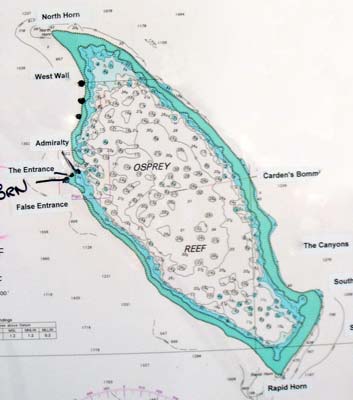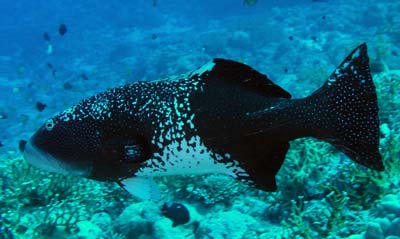 |
A chart of Osprey Reef
North Horn is at the very top |
Osprey Reef is located approximately 130 kilometres off the Great Barrier Reef in the Coral Sea. It is about 200 kilometres from the mainland. The reef itself basically runs from north-west to south-east and is about 30 kilometres long and 10 kilometres wide. There is a single decent entrance to the only lagoon (which is about 25 to 27 metres deep for the most part) that is located about two thirds of the way from the southern point to the northern point. Boats steam to Osprey from the GBR overnight, with most boats taking about 10 to 12 hours depending on the conditions and where you are leaving the main reef.
North Horn is the very northern point of Osprey Reef. The GPS Reading is S13° 48' 05.2" E146° 32' 45.7" using WGS84 as datum. It is approximately 320 kilometres from Port Douglas. The location obviously gets its name from the shape of the reef which from the air looks like a horn on a unicornfish or similar. There are two sections of reef to follow. One is the western side and the other is the northern side.
Where the two main sections of the reef join, they do not meet in a < shape but more in a blunt [ shape. That is, there is a section of reef between the reef coming from the south (the one facing west) and the reef coming from the east (the north and east facing one) are joined by a short section that runs for perhaps 50 metres. Deeper, the reef goes to a point. The depth there is about 35 to 40 metres.
There is a mooring on a bommie in about 12 metres of water at the above GPS reading. Behind the bommie there is a sort of amphitheatre (more about this later) and behind that a largish overhang and swim-through. More about this later as well.
The current (when it is running) here mainly comes from the south and east. This means that you will have to swim into the current no matter which way you pick to go unless you get a rare day without a current (from one or both directions). On the days I dived here there was no current from the south but a slight current from the east. The best dive is along the western wall to the south.
 |  |
| Kelly McFadyen and one of the gorgonias at North Horn | Another of the gorgonias at North Horn |
From the boat drop to the sloping sandy bottom. As you you descend, look out for the many sharks that you will see on this dive. Once on the bottom, head to the south. Soon you will see that the reef drops from the shallow five metres in an almost vertical wall for 20 metres or so and then in a steeply sloping wall to about 40 metres. From here it drops to over 400 metres. Follow the wall at about 35 metres to start and start a very gradual ascent. There are some fantastic gorgonias, soft corals and coral whips. You can take some excellent photographs all along this wall. Look out to the open water as you go and you will probably see some sharks (white-tipped reef mostly, but also grey whalers and silver tipped).
The wall has numerous overhangs and back cuts. These are home to soft corals of all colours. The yellow and orange ones are the most attractive.
 |  |
Mark Ridsdale and Janine Jenkins
and a white-tipped reef shark at North Horn | A different coloured coral trout at North Horn |
There are lots of coral trout all along the reef. They are mostly near the top of the walls but some are deeper. They are not like the normal coral trout that are red or orange, these ones are black with white band across their middle and some white spots on other parts. You may also see some pelagis species.
When you have used up half your air or bottom time, turn around and head back towards the mooring. Keep coming shallower as you go. There are more soft corals and some very large gorgonias.
 |  |
| A female steephead parrotfish at North Horn | A pair of racoon butterflyfish at North Horn |
When you get back to the mooing area, examine the swim-though to the south-east of the mooring (mentioned at the start of the article) and look at all the walls of the bommies and main reef. There are some anemones and clownfish, some nice painted moray eels (I found an extremely friendly one in 2006) and more.
I have two other dive descriptions for this location, see North Horn Shark Dive and North Horn Drift Dive. Visibility here is nearly always at least 40 metres.
Click here to return to the Osprey Reef article page.
| 
 v6.00.307 © 2003-2005
v6.00.307 © 2003-2005